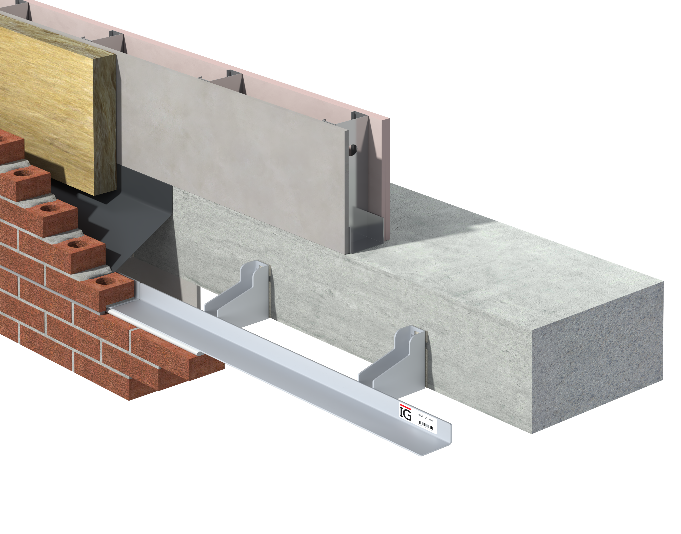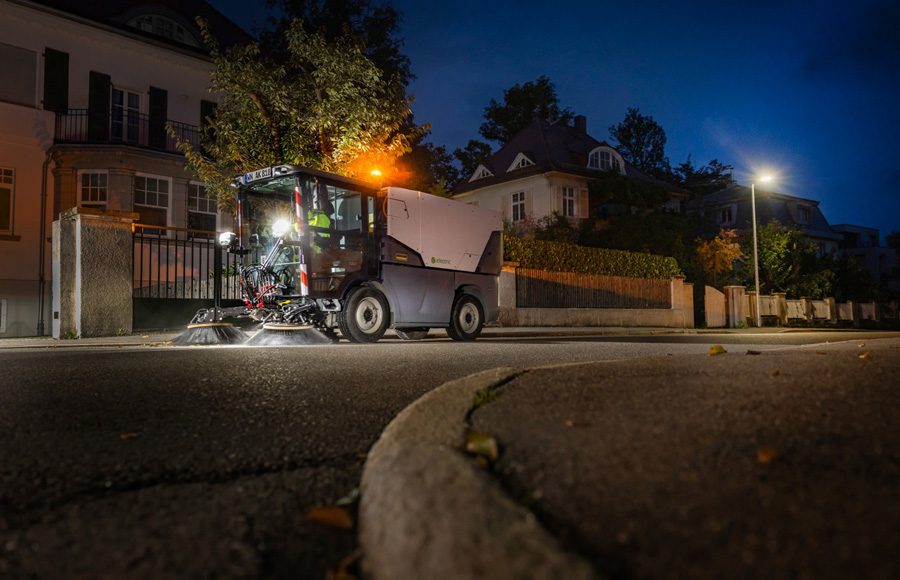Formerly a seedy area
worth avoiding, London's Kings Cross has now been transformed into a go-to
destination for office workers, students and tourists.
Developer Argent's
regeneration of the area has sensitively re-purposed the early Victorian
railway buildings into variously, a college campus, supermarket and offices, in
which the interior changes are radical but the exteriors have been left largely
unaltered.
Not so
for Coal Drops Yard, a pair of elongated Victorian coal warehouses originally built to
distribute coal from the North of England across London. Here, the pitched
roofs of two almost-parallel buildings, 150m and 100m in length and 39m apart,
have been reconfigured to curve up at their northern ends and gently kiss each
other.
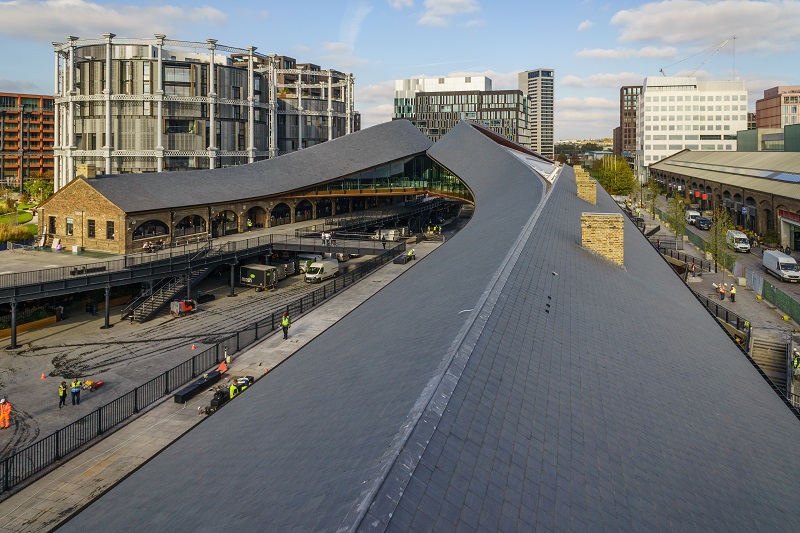
Designed by
Heatherwick Studio, the roofs peel upwards and extend into the middle of the
space between the two buildings. A new floorplate sits below the roof
structure, with glazing filling the gap between the two, creating a third level
of retail.
The new roofs of the
ornate cast-iron and brick structures have been slated with 92,000 new versions
of the original Welsh Slates - 500mm x 250mm Cwt Y Bugails from the
manufacturer's Llan Ffestiniog quarry in North Wales - by Banbury-based
specialist sub-contractor Attleys Roofing.
Attleys already had
some Kings Cross experience, using 6,400 500mm x 300mm Heather Blues from Welsh
Slate's main Penrhyn quarry for the re-roof of the nearby German Gymnasium -
the first purpose-built gym in England - which is now enjoying a new lease of
life as a designer restaurant.
Coal Drops Yard was a whole new ball game, testing Attleys to the limit, but the result
is an extraordinary reinterpretation of the canal-side site.
Main contractor BAM
Construction was responsible for the structure of the new roofline. More than
50 new steel columns were carefully threaded through the existing structure to
support the roof independently of the building, a point cloud survey being carried
out to help calculate where to put the columns without clashing with the
existing building fabric.
Primary support is
provided by a set of large cranked beams supported on cores in each building
which join in the middle over the yard. There are four primary beams, two on
each building. These dip down towards the centre to create the valley between
the two roof structures and have been nicknamed "giraffe beams" in
reference to their angled neck and head - the structure looks like two giraffes
rubbing noses together. Tie beams at floor level take the tensile loads
generated by the weight of the roof.
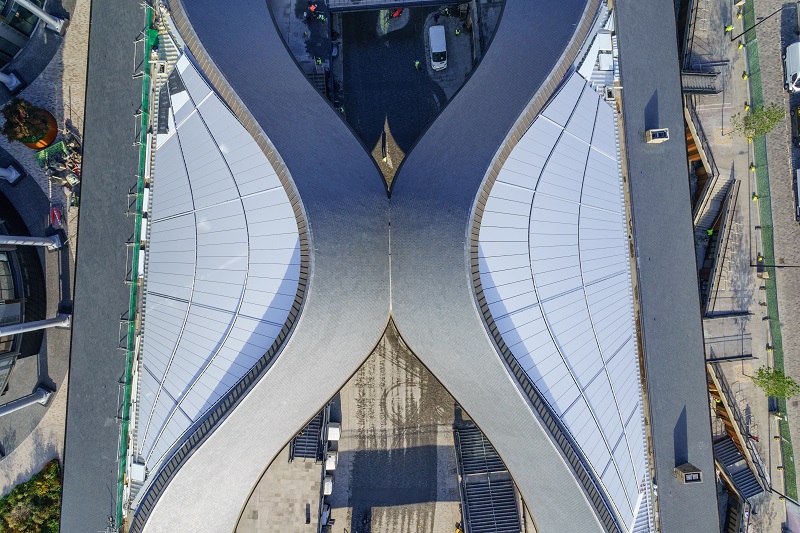
The giraffe beams
support two ribbon trusses that define the upper and lower edge of each roof
structure and connect in the middle over the yard at the lower edge. These are
7m deep in the middle and taper to 5m at the ends where these join the existing
roof. Tubular steel sections were used to create the trusses because of the
complex geometry.
The new floorplate
below the roof is suspended from above using macalloy bars and is tapered
towards the perimeter to minimise the impact on the view. More than 60 panels
of full-height structural glazing between the floor and new roof are stepped
rather than curved or faceted for aesthetic reasons and has the added benefit
of hiding the macalloy bars.
Temporary trusses were
erected to support the giraffe beam assembly and ribbon trusses during
construction. The giraffe beam assembly was erected first. The ribbon trusses
were brought to site as components, bolted together on the ground into
fully-assembled sections complete with rafters, craned into position and bolted
together where they meet in the middle. The whole roof structure was then
de-propped.
Visually, it was
important to maintain a seamless transition from the existing roof to the new
section so the original timber roof trusses were retained where possible, with
some localised strengthening required where the timber had been damaged. The
gap between the existing and new roof structure was then boarded over ready for
the new Welsh slates.
The two
roofs are bolted together where they meet in the middle. Heatherwick Studio
chose to position the new roof element at the northern ends of the two
buildings as the eastern building had been devastated by a fire in 1985. Used more
recently for warehousing and nightclubs, they were largely abandoned in the
1990s.
Group leader Lisa
Finlay said: "Our challenge was to radically remodel this Victorian
infrastructure to meet the needs of a modern urban development without losing
what made them special.
"To do this, we
focused on understanding their original function and how they were adapted over
time so we could appreciate how best to preserve and reuse the existing fabric,
whilst also introducing new elements. One of which is an entirely free-standing
new structure threaded through the historic buildings, from which a spectacular
new third level is suspended."
Attleys were on site
for a total of almost 18 months. The roof pitch of the original sections of
roof was 28° but as the curves swept around and met in the middle this changed
to 47°. Thereafter the length also decreased from 8.4m to 6.9m at the kissing point
where the two curved roofs met but the same number of courses of slates (44)
had to be maintained.
This meant Attleys had
to decrease the gauges and not only cut the sides of the slates to take them
around the curve but also the tops of the slates to maintain the same number of
courses. No clever nailing or hidden bibbing was required to stop rainwater
flowing diagonally at this point as the pitch was so steep.
Attleys' managing
director Shaun Attley met with Heatherwick Studio and BAM's design team up to
two years prior to commencement on site to discuss the design issues and how to
achieve the aesthetics requested while using the products selected.
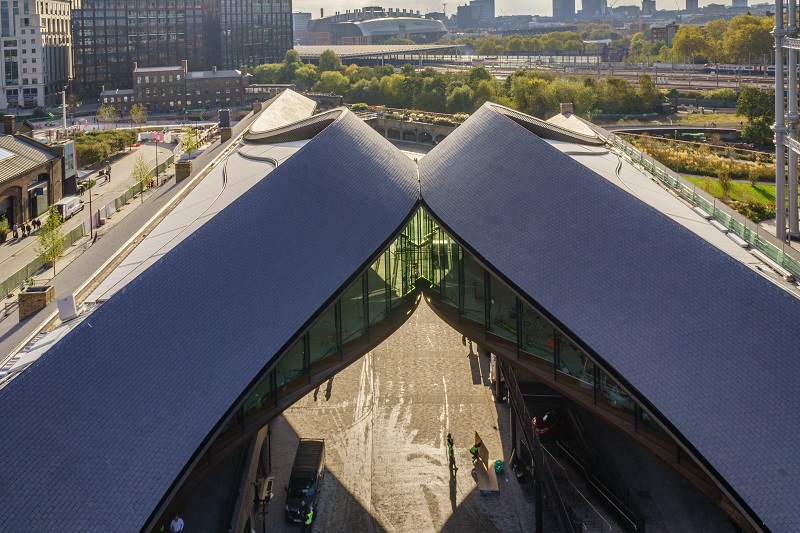
Shaun advised the
project team that the Cwt Y Bugail slates could not be used for their initial
roof design which exceeded a 90° pitch so it was re-designed to ensure that
where the eaves met it was at a pitch commensurate with Welsh Slate's fixing
recommendations and warranties.
Due to space being at
a premium, all the Cwt Y Bugail slates were cut off-site at Attleys' depot in
Banbury. To do this, Attleys had to calculate how much of the slates needed
cutting off. This was done by taking measurements from the steel work underneath
- from steel to steel at the eaves and steel to steel at the ridge which was
generally over 10-15m depending where you were on the curve (on the internal
curve or external curve). The kissing point determined how the slates were cut
to ensure the perp lines and side laps were maintained.
And
because the roof pitch was increasing while the rafter length was decreasing,
Attleys also had to cut the tops of the slates down so they suited the
decreasing gauges. A total of 32,000 of the 90,000 slates used on the project
had to be cut with hand guillotines so the dressed edge could be maintained
around the curve which comprised 1,600m2 of the total 4,600m2.
Shaun Attley said:
"Our timescale for the sections of roof was provided to BAM Construction
and this was put into their overall programme with all other sub-contractors
but unfortunately our commencement on site was delayed due to previous issues
in the construction of the steel frame prior to us starting.
"This meant we
were up against the clock in trying to pull back time to ensure the overall
programme was still met and we were asked by BAM to find ways of doing as much
as possible off-site and increasing labour and production on-site to pull back the
time lost. By working together with other sub-contractors and the main
contractor we managed to finish a week earlier than our anticipated 43-week
overall programme."
He added: "The
project was challenging at the beginning to ensure we set the roof out properly
but as the contract progressed it became easier. Welsh slates are easy to work,
and we work with them all the time, but in this case it was challenging getting
the slates to course all the way round.
Attleys' SMSTS-trained
supervisor ran the day-to-day safety, conducting Toolbox talks every morning
and attending daily safety briefings by BAM Construction staff and supervisors
from all trades on site to brief each other of any risks and ensure trades were
not disrupting one another.
The team of 10 Attleys
operatives, which included two NVQ Level 2 apprentices, carried out daily
visual inspections of tools and all power tools were PAT tested every three
months. Shaun Attley visited weekly to inspect the job for workmanship and
production and also to gather feedback on any safety issues or to see if any
safety measures could be instigated to improve the overall safety for their and
other operatives on site.
"We found some of
these measures not only improved safety but also helped improve
production," said Shaun.
Attleys also had an
independent safety inspector (from The Health & Safety People) visit site
monthly to see if there were any safety improvements they could recommend.
Far from handling
eight million tonnes of coal a year, Coal Drops Yard is now forecast to pull in
12 million visitors a year.










